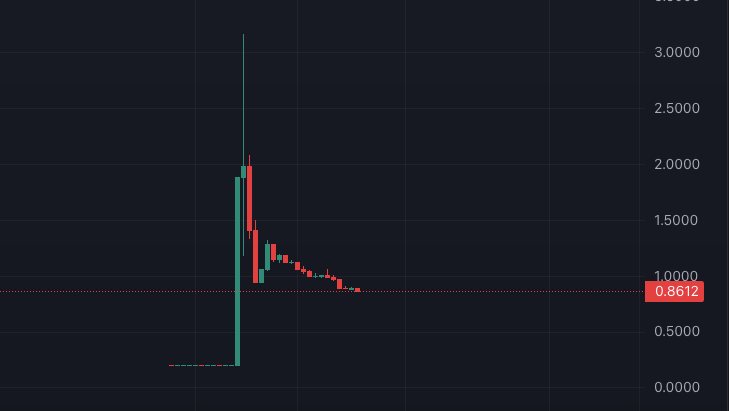
A volatile price chart of the $YZY memecoin, showing its rapid rise from $0.19 to $3.16 and subsequent decline to $0.88, reflecting potential insider trading and market manipulation.
On August 20, 2025, a new cryptocurrency named $YZY, allegedly tied to rapper Kanye West (now known as Ye), launched on the Solana blockchain, igniting a firestorm of speculation and suspicion within the crypto community. The token’s debut, marked by a meteoric rise and subsequent crash, mirrors the volatile patterns of other celebrity-backed memecoins like $TRUMP, $MELANIA, and $LIBRA, raising questions about insider trading, market manipulation, and potential scams.
Here’s a detailed look at all of the $YZY drama, its connections to prior memecoin controversies, and the unfolding narrative.
The $YZY Launch
The $YZY token launched at approximately $0.19 and skyrocketed to a peak of $3.16 within 40 minutes, briefly achieving a market capitalization of $3 billion, according to data from GeckoTerminal and CoinGecko. However, the price quickly began to bleed, dropping to $0.88 by the time of writing, a decline of over 70% from its high.
This pump-and-dump pattern is strikingly similar to other celebrity memecoins, prompting immediate scrutiny. Kanye West announced the $YZY token via a post on X, describing it as part of the “YZY Money” ecosystem, which includes a Ye Pay payment processor and a YZY Card for global spending with $YZY and USDC.
The project’s website touts it as a “new financial system built on crypto rails,” with anti-sniping measures like deploying 25 contract addresses to obscure the official token and deter early buyers.
Despite these efforts, on-chain data revealed significant red flags: 94% of the token supply was held by insiders, with a single multisig wallet controlling 87% before distribution, according to Coinbase director Conor Grogan.
Additionally, the liquidity pool was seeded solely with $YZY tokens, not paired with USDC, allowing developers or large holders to manipulate liquidity and potentially cash out which interestingly is a structure reminiscent of the controversial $LIBRA token.
Kanye’s Warning and the Shadow of Past Scandals
Months before the $YZY launch, Kanye West publicly warned on X about a group attempting to exploit his name for a fraudulent memecoin, claiming he rejected a $2 million offer to promote a scam.
He stated,
“I’m not doing a coin. I only do things I’m passionate and knowledgeable about. Coins prey on the fans with hype.”
Yet, his apparent reversal to launch $YZY has fueled speculation about whether his account was compromised, sold, or influenced by external parties. Some X users, like
@CryptoGirlNova, have suggested that Kanye may have sold his account to a group called BarkMeta Doginals for $17 million, though this remains unverified.
The $YZY launch coincides with a significant development in another memecoin scandal: on the same day, a judge unfroze $57 million in USDC tied to Hayden Davis, a central figure in the $LIBRA scandal earlier in 2025.
Related: The $Libra Scam – Politicians & Major Conspiracies!
Davis, a 28-year-old American crypto marketer, allegedly admitted to orchestrating the launches of $LIBRA, $MELANIA, and $TRUMP, profiting millions through insider trading and sniping, buying tokens at low prices before public launches.
The timing of the unfreezing and $YZY’s debut has led to speculation that Davis or associated parties may be involved, though no direct evidence confirms this.
The $YZY scandal is part of a broader wave of celebrity memecoin controversies that began with the $TRUMP token in January 2025, followed by $MELANIA and $LIBRA. The $TRUMP token, launched just before Donald Trump’s inauguration, saw a similar pattern of a rapid surge to a $4 billion market cap before crashing, with insiders reportedly pocketing $100 million in trading fees.
The $MELANIA token, launched a day later, hit a $2 billion valuation before plummeting 96% to $0.51, with blockchain analytics firm Bubblemaps reporting that the team, including Davis, covertly sold $30 million from community funds.
The $LIBRA scandal, tied to Argentine President Javier Milei, was particularly explosive. Promoted by Milei as a tool for economic growth, $LIBRA soared to a $4.5 billion market cap before crashing 85% within hours, erasing $250 million in investor value.
Blockchain data showed that nine founding accounts, holding 70% of the supply, profited $87 million. Davis, who claimed to be an advisor to Milei, admitted to sniping $LIBRA and $MELANIA, defending it as a tactic to “protect” the tokens from other snipers. His actions, however, sparked allegations of a rug pull, leading to lawsuits, fraud complaints, and calls for Milei’s impeachment.
Adding to the intrigue, Bubblemaps revealed on August 21, 2025, that the first buyer of $YZY was a trader known as Naseem, who previously turned $1.1 million into over $100 million on $TRUMP. Suspicious?
On-chain analysis by pseudonymous sleuth Dethective linked a $YZY sniper wallet, which made $1 million in profit from a $250,000 purchase, to a treasury wallet that also received $21 million from $LIBRA snipers, suggesting a coordinated network of insiders across these launches.
Hayden Davis, the CEO of Kelsier Ventures, has emerged as a pivotal figure in these scandals. Operating with his brother Gideon and father Tom, a convicted felon, Davis has been linked to multiple pump-and-dump schemes. In a February 2025 interview with YouTuber Stephen Findeisen (Coffeezilla), Davis admitted to profiting $113 million from $LIBRA and described memecoins as an “insider’s game” in an “unregulated casino.”
He claimed to hold $100 million from $LIBRA, intending to re-inject it to stabilize the token, but no such action materialized. Davis also denied bribing Milei or his sister Karina, though leaked messages reported by La Nación suggested he boasted about controlling Milei through payments.
On-chain investigations, including by Cyvers and Dethective, have tied $YZY sniper wallets to the same network involved in $LIBRA, extracting a combined $23 million in insider gains across both tokens.
While Davis’s direct involvement in $YZY remains unconfirmed, the parallels in token structure, insider-heavy distribution, and timing with the unfreezing of his $57 million in USDC have fueled speculation.
The crypto community has reacted with outrage, with X posts labeling $YZY as a potential “rug pull” and drawing parallels to $LIBRA’s collapse. Blockchain security experts like Yu Xian have highlighted how scammers exploit celebrity endorsements, often claiming hacks to deflect blame.
The $YZY token’s tokenomics has 70% allocated to Yeezy Investments LLC, 20% to investors, and 10% to liquidity. This interesting structure mirrors $TRUMP and $LIBRA, raising concerns about market manipulation risks.
S Taylor is a crypto trader with five years of experience, having navigated a wide range of market dynamics and witnessed numerous scams firsthand. As a former victim of scams, S Taylor turned their focus to blockchain forensics and Solidity Smart Contract development, gaining deep technical expertise in the field. With a unique insider’s perspective, they’ve been involved in various crypto projects, where they’ve seen how developers can exploit vulnerable investors.
S Taylor is also the published author of Meme Coins Made Easy, a comprehensive guide that teaches beginners about cryptocurrency and how to identify and avoid common scams. S Taylor is dedicated to sharing valuable insights and helping the crypto community stay informed and safe.
Disclaimer: This article is for informational purposes only and should not be considered legal, tax, investment, or financial advice.


